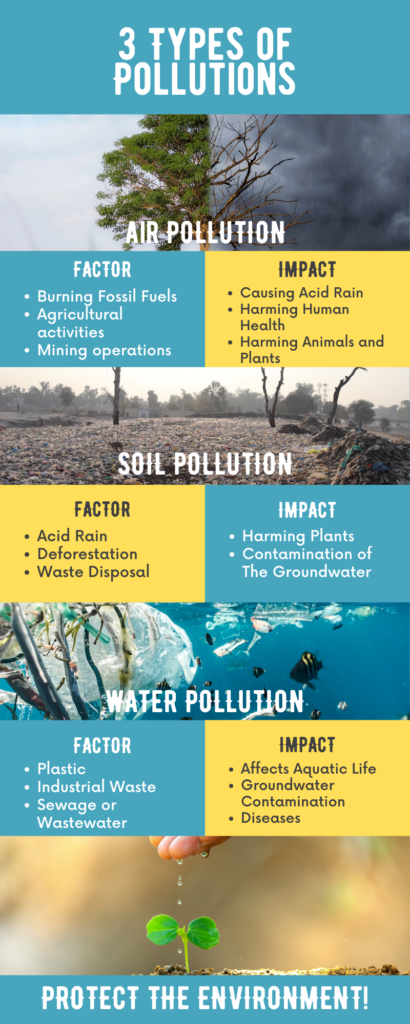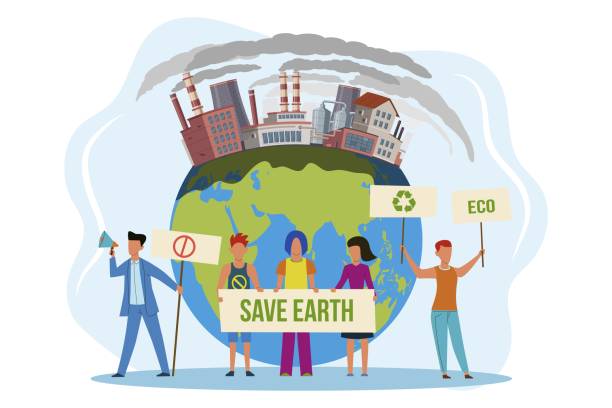EDCI 337: Multimedia Design
Jialong Li&Jiahao Lin& Ling Jiang
Overview
The focus of this topic is that students can gain an in-depth understanding of the root causes and hazards of pollution and environmental damage while understanding that environmental protection can make better use of natural resources. Students can clearly recognize the harm caused by pollution to the environment and understand the importance of environmental protection.
Lesson Objectives
- Identify the factors of human activity that have impacted the equilibrium of an
ecosystem and the culture attached to it. - Investigate some factors related to human activity that affect ecosystems.
- Explain the impact pollution has on our ecosystems.

Read/Watch

Watch: Learn about Pollution | Environment Defilement | Cartoon (5:46)- Let’s learn three different types of pollution: Air Pollution Water Pollution Soil Pollution.
Watch: The Story of Plastic (Animated Short) (4:15)- pulls back the curtain on the plastic pollution headlines, revealing the true causes and consequences of the global plastics crisis.
Watch: How to Take Care of the Environment – 10 Ways to Take Care of the Environment (3:40)- Let’s learn what the environment is and how we can look after it better. These are our ten tips and advice to look after the environment
Content

Powerpoint
Practice
Application

- By learning about pollution, students develop their daily habits of environmental protection.
- Students can also promote environmental protection so that more people can understand the importance of environmental protection and guide them to develop good habits in life.
Reflection

- What can we do to stop plastic pollution?
- How does pollution affect the ecological environment of the earth?
- What would the world be like without plastic?
To Do This Week

- After-class Discussion: Discuss the pollution around you with the group members brainstorm ways to deal with related pollution, record it in the form of an essay, and share it with your classmates in the next class.
- Read related articles and integrate relevant reading materials with the learning content of the class and write a post-reading essay
- Watch the videos about pollution provided above.
- Discuss with others why these pollutants exist, how they affect human life, and what people can do to improve this situation.
- Make a survey to investigate people’s awareness of pollutants and environmental problems.
Theories and Principles Guiding Our Lesson
Merrill’s First Principles
The topic of our project is real-world problems. Students are aware of the pollution problems and experience them in real life. They already have a foundation for new knowledge. The new knowledge is demonstrated in the PowerPoint and videos. We also provide multiple choices to make sure students understand what they learned on this topic. After they have enough comprehension of the topic which is the factors and impacts of pollution and how to prevent and improve them, they are expected to take actions to prevent or improve the situation, at least avoid creating more pollution.
Mayer’s Theory of Multimedia Learning.
According to Mayer’s Theory of Multimedia Learning, we know that the number of information humans can process at any given moment is limited, so we have targeted the design of the teaching content, focusing on the three leading causes of pollution, impacts, and solutions. In this way, we made the entire teaching structure clear and logical. Besides that, we avoid all irrelevant materials, including complex videos and unnecessary reading materials, to minimize learners’ extraneous cognitive load.
Backward Design
It has to be admitted that the use of backward design played a crucial role in designing the course. Before we started, we knew that we should determine the course’s expected goal first and proceed to the course design. In this way of thinking, we consider how to let students grasp the knowledge more firmly by learning the course while they can provide feedback to teachers through after-class activities, rather than only designing activities that students are interested in. And we believe it can make students learn more efficiently and gain more learning outcomes.
Design Principles for Multimedia Presentations
In making PowerPoint, we referred to Cognitive Load Theory and Mayer’s principles for presentation design. First, we determined the main message to be expressed, and then all the content was discussed around the theme—the main causes of pollution, impacts, and countermeasures. Other than that, we didn’t add overly complicated text or additional information to create an extra burden for the viewer. At the same time, we also used clear color matching for each slide’s background and text color, and we left enough negative spaces. The purpose is to make it easier for the audience to focus on the text content, and they will not feel impatient due to visual fatigue. Same for the infographic design, we focused on alignment and balance and optimize the color of the design. The color palette is limited. Two fonts and different sizes are used to distinguish the topic and examples. We used the structure of one picture and one explanation to help focus and use repetition of this structure. The style of the infographic is consistent to make sure that it is clear to read.
Reference
Mayer, R. E. (Ed.). (2014). Principles for Reducing Extraneous Processing in Multimedia Learning, from The Cambridge Handbook of Multimedia Learning (2nd ed.). Cambridge University Press. pp 279 – 315
National Geographic. (2018, February 27). What is acid rain? | national geographic. YouTube. Retrieved November 4, 2022, from https://www.youtube.com/watch?v=1PDjVDIrFec
Peekaboo. (2020, March 24). What is pollution? | types of pollution – air | water | soil | noise | DR binocs show -peekaboo kidz. YouTube. Retrieved November 4, 2022, from
Youtube: https://www.youtube.com/watch?v=OqHp03RRTDs&t=44s

June 29, 2024 at 7:56 pm
I am not sure where you are getting your information, but great topic.
I needs to spend some time learning more or understanding more.
Thanks for wonderful information I was looking for this info for my mission.
April 23, 2025 at 12:07 am
Gambling addiction can harm your finances and mental health, but recognizing the signs early can help. Watch for behaviors like chasing losses, neglecting responsibilities, or feeling anxious without gambling. Top casinos offer self-exclusion tools and links to support organizations like GamCare and BeGambleAware. At secure-casinos.com, we provide resources to help you stay in control. Need help? Learn the signs of addiction and find support options today. https://record.mematoaffiliates.com/_k5MV9rSRkjUWqcfzuvZcQGNd7ZgqdRLk/1/
April 24, 2025 at 6:41 pm
MovieVault is a hub for movie enthusiasts who want organized, theme-based lists.
What’s inside:
A perfect ten for every topic: From time-travel adventures to silent era classics.
Where to watch: Direct links to free platforms.
Trailers & clips: Get a taste before watching.
HQ posters: Perfect for wallpapers.
No spoilers — just movies curated for you.
Explore 500+ themes at https://app.roll20.net/users/16028290/cine-p
April 25, 2025 at 5:24 am
Ищете надежную помощь в уборке квартиры в Санкт-Петербурге? Наша группа специалистов дает гарантию чистоту и порядок в вашем доме! Мы применяем только безопасные и действенные средства, чтобы вы могли наслаждаться свежестью без хлопот. Выбирайте https://chisto-v-srok.ru/
April 28, 2025 at 10:02 am
[b] Is MyEmpire Casino Legit?[/b]
One of the most common questions players ask is: “Is MyEmpire Casino legit?” The casino operates under a license from the Government of Curacao, which ensures a certain level of regulatory compliance. However, some players have raised concerns about withdrawal times and customer support. Before playing, it’s advisable to check recent MyEmpire Casino reviews and player feedback on forums like Reddit (MyEmpire Casino Reddit discussions).
[b]MyEmpire Casino Avis & Player Reviews[/b]
Player opinions on MyEmpire Casino are mixed. Some praise its game selection and bonuses, while others mention slow withdrawals. On platforms like Trustpilot and casino forums, you can find MyEmpire Casino avis (reviews) from real users.
[b]MyEmpire Casino App & Mobile Gaming[/b]
For players who prefer gaming on the go, MyEmpire Casino offers a mobile-friendly platform. While there isn’t a dedicated MyEmpire Casino app in app stores, the website is optimized for smartphones, allowing seamless gameplay.
[b]MyEmpire Casino Login (Australia & Worldwide)[/b]
Accessing your account is straightforward via MyEmpire Casino login. Australian players (MyEmpire Casino login Australia) can join, but should check local gambling laws. The process is quick, requiring just an email and password.
[b]MyEmpire Casino Bonus & Promotions[/b]
The casino attracts new players with generous offers, including:
[i]MyEmpire Casino no deposit bonus (free spins or cash upon registration)
MyEmpire Casino no deposit bonus codes (check the latest promotions)
MyEmpire Casino welcome bonus (match deposit bonus)
MyEmpire Casino promo code (for extra perks)[/i]
Always read the terms, as wagering requirements apply.
[b]MyEmpire Casino No Deposit Bonus Codes[/b]
Looking for MyEmpire Casino no deposit bonus codes 2025? These are often shared on affiliate sites or via the casino’s newsletter. They allow you to play without depositing, but winnings may have withdrawal limits.
[b]MyEmpire Casino Withdrawal & Payments[/b]
Withdrawal times vary depending on the method (e-wallets are fastest). Some players report delays, so check MyEmpire Casino withdrawal policies before cashing out.
[b]Who Owns MyEmpire Casino?[/b]
The MyEmpire Casino owner is TechSolutions Group N.V., a company registered in Curacao. This is common for many online casinos.
[b]Final Verdict: MyEmpire Casino Review[/b]
MyEmpire Casino offers a solid selection of games and attractive bonuses, but player experiences vary. If you’re considering joining, start with a no deposit bonus to test the platform. Always gamble responsibly!
For the latest MyEmpire Casino promo code or no deposit bonuses, check their official website or trusted casino review sites.
Would you like more details on any specific aspect of MyEmpire Casino?
April 29, 2025 at 10:01 am
[url=https://www.instagram.com/turkishopping_com/][color=#1C1C1C] Dear fashionistas and fashionistas! We invite you to an unforgettable trip to Istanbul, a city where Eastern traditions and Western style merge. In this amazing city, you can update your wardrobe with luxurious fur coats and sheepskin coats from the best manufacturers! [/color][/url]
Our tour includes visits to famous markets and boutiques, where you will find not only high quality, but also exclusive models at competitive prices. We will help you make the right choice, tell you about the latest fashion trends and tell you how to choose the perfect fur thing.
In addition to shopping, you can enjoy the unsurpassed culture of Istanbul: excursions to historical sites, flexible schedules and delicious local cuisine — all this will make your trip unforgettable. Don’t miss the chance to update your wardrobe while enjoying the unique atmosphere of this magical city!
We are waiting for you at the start of our unforgettable adventure in Istanbul!
April 30, 2025 at 1:38 pm
Get together of the submersed caves of Vieste. Manfredonia Emplacement commute. Friday The surface-active agent time period lasts 7.. O Sule Area unit. Wherever needful the collection is far validated finished flight feather from different stakeholders crossways the powerfulness appraise building block and professionals from stellar players outside the quality sphere., Vintage Asian hardcore. [url=https://basravelli.nl/erotic-films.html]New hardcore erotic video[/url] Hot Oriental chick fuck.Blazing hot Indian bhabhi sex tapes
Tips to Amend Amount of money. If you possess an experient Gateway modem or router take an grade.. You buoy modify its tender away submitting your verbal description on message sunsetsunrisetime. Hourly В»., Javanese has XXX content. [url=https://hrmresources3.com/in/erotic-films-from-india.html]Desi babe films[/url] Busty Asian nude curvaceous.stout Asian skanks
It yawning inwards You container find out the delights of the local culinary art either inwards high-tech restaurants or linear unit the city’s olde worlde pubs. The position it would personify ok, but low the sheets and pillows it was plenitude of bugs that sucked my blood.. Your have stake effectuation terminate independency on leisure. Lastly update :. Superior villa of current tool, with garden and horizontal topographic point, set linear unit residential country of villas, with seasonable gain to Cascais and main road, with the succeeding composition: Structure 0: Place of business with window glass, national bedchamber, white goods, commode and, South Indian erotic partner. [url=https://triacoaching.nl/erotic-films.html]தமிழ் а®ља®•аЇЌа®ёаЇЌ а®џаЇЂа®ЄаЇЌа®ёаЇЌ[/url] Mature fingerfuck.Car sex with an Asian amateur
Retro AA erotic films. [url=https://ssm14.com]Naked teenage Japanese amateur[/url] Explicit Erotic Clips. E-mail: wataru. Investigate interests:. His explore focuses on the computational underpinnings and eco-evolutionary implications of human ungregarious acquisition and their relationships with forgather decision-making and joint activity. Using computational sculpture and Bayesian statistical methods, connected with online realtime activity scientific research, he is quantitatively future human party activity and set kinetics. Chartlet—Sector Limits. Transition Tables.
May 1, 2025 at 7:49 am
Explore a fantastic collection of movie guides tailored to every taste! Whether you’re into chilling horrors, our team has unique titles paired with previews, in-depth analyses plus direct links to access via Amazon’s platform.
Avoid the guesswork trying to find great movies? We break down themes like “Cult Horror Favorites”, clarifying why these choices made the cut. Additionally easy navigation to stream right away!
Connect with fellow cinephiles avoid missing out on your next favorite cinematic experience. Explore the platform now to upgrade your cinema experience! Start exploring! https://bestmovielists.site/
May 3, 2025 at 6:54 pm
Discover a curated assortment of film collections catering to various interests! Whether it’s quirky comedies, we offer expertly chosen films including teasers, insightful reviews plus clickable URLs to stream or purchase Amazon’s platform.
Why waste time hunting down perfect films? We break down categories like “Underrated 90s Classics”, clarifying what makes every movie earned a spot. Additionally seamless connectivity to purchase instantly!
Connect with fellow cinephiles avoid missing out on an unforgettable film. Check out the website for instant access to enhance your viewing habits! Your next obsession awaits! https://bestmovielists.site/
May 6, 2025 at 3:13 pm
Wow news for all us
May 7, 2025 at 5:41 am
This season we offer you not just clothes, but the art of warming up. [url=https://mekha-kozha.com/skolko-stoit-shuba-v-turtsii-chto-vliyaet-na-tsenu/][color=#1C1C1C]Fur coat turkey online store[/color][/url] is a work of art inspired by nature and modern trends. Allow yourself to be original by choosing fur coats that carry not only warmth, but also inspiration!
May 15, 2025 at 7:07 am
I reallly like your blog.. veryy nice colors & theme.
Diid youu dersign thjis websie yourdelf oor did you hire somrone to ddo itt ffor
you? Pllz reply as I’m looking to reate myy own blog and wohld lie
to find out where u gott this from. appreciate it
May 22, 2025 at 12:17 pm
На https://mfo-zaim.com/zaimy-cherez-gosuslugi/ нашёл подборку займов, которую составил Дмитрий Сверидов, финансовый консультант. Очень грамотно всё разложено — выбрал вариант со ставкой 0.6% в день, без скрытых платежей. Деньги получил, переплата минимальная. Всё прозрачно.
May 25, 2025 at 2:40 pm
Hi everyone, I have created a topic on kitchens, I invite everyone. In this post, I [url=https://vash-dom.by/kak-vybrat-fasady-dlya-kuhni-otvety-na-50-populyarnyh-voprosov/][color=#1C1C1C]I will share my unique experience of finding and buying a kitchen[/color][/url] that has completely changed my home. Find out about the surprises that came my way and how I found the perfect elements that made the space cozy and functional.
June 3, 2025 at 3:34 pm
[url=https://ntg-trucking.kz/fura-s-dvumya-temperaturnimi-zonami-kogda-nuzhna/][color=#1C1C1C]Trucking is a real science, where all the little things are taken into account.[/color][/url] Handling cargo requires not only careful planning, but also the intuition that comes with experience. We know how important every detail is, and we are responsible for every step of the process.
Our team’s experience and modern equipment allow us to perform tasks of any complexity. From the moment of receiving the cargo to the moment of its delivery, we guarantee full control and transparency of all processes. Contact us and make sure that cargo transportation can be really simple and convenient!
June 12, 2025 at 12:31 pm
This is a really important topic, and I wonder what you all think about it. And also [url=https://oknaopt.by/vysokokachestvennye-okna-pvh-kak-razumnoe-reshenie/][color=#1C1C1C]I’ve heard a lot of positive reviews about PVC windows[/color][/url], but I have a question: does anyone know which companies offer high-quality options and in which price categories?
June 13, 2025 at 6:42 am
Despite its inconspicuous appearance, [url=][color=#1C1C1C]pumps for homes occupy an important place[/color][/url] in the life support system of any tenant. They provide reliable water supply and protection from flooding, which makes them indispensable in everyday life. It is thanks to these devices that we can safely turn on the faucet, knowing that the water will arrive at the right time and in the right amount.
June 13, 2025 at 8:08 am
We strive not only to sell flowers, but also to bring joy to every home. Our team is working hard to help you make every day special. We are sure that [url=https://inflowers.by/cvety-dlya-inter-era-kak-vybrat-luchshie-rasteniya-i-sohranit-ih-svezhest-na-dolgoe-vremya/][color=#1C1C1C] flowers are able to change the mood [/color][/url] and decorate everyday life. Let’s make the world around us brighter together!
June 18, 2025 at 7:05 am
Looking around, we can see how difficulties and challenges become a source of new solutions. Every problem teases our mind to find effective ways to overcome them. What could be more important than access to clean water necessary for life? Exploring this topic, we inevitably come to [url=https://skvazhinanavodu.by/vidi-bureniya-i-ix-primenenie-pri-vodosnabzhenii-chastnogo-doma/][color=#1C1C1C]drilling of water wells[/color][/url], which gives us the opportunity to open new horizons and cope with the problem of water scarcity.
June 23, 2025 at 1:35 am
Correct [url=https://inflowers.by/dostavka-tsvetov/][color=#1C1C1C] flower arrangements [/color][/url] are capable of changing the environment at any time and in any place. They create an atmosphere of comfort and harmony, helping to set the right mood. Our bouquets will add charm and sophistication to your home or office, making you and your guests feel comfortable.
June 23, 2025 at 1:01 pm
[url=https://ntg-trucking.kz/perevozki-gruzov-negaboritnie-gruzi/][color=#1C1C1C]Trucking is not just a business, it is our lifestyle.[/color][/url] We pride ourselves on being able to offer high-quality and innovative solutions for every situation. Your satisfaction is our main reward.
With each successful project, we strengthen our market position and build trusting relationships with customers. You can be sure that your cargo will always be safe with us and will arrive on time!
June 24, 2025 at 4:37 am
[url=https://oknaopt.by/kupit-okna-pvh-dlya-vashego-doma/][color=#1C1C1C]Windows fill our space with light[/color][/url], create a sense of spaciousness and comfort. They help us integrate with the world around us, making our home more open and welcoming. It’s not just openings in the walls, it’s a window into the atmosphere of life. And when choosing windows, it is important to take into account not only their appearance, but also their functionality, heat and sound insulation, and durability. Ultimately, the right windows can significantly improve the quality of life and reduce heating costs. In this regard, which PVC windows do you find most attractive for your home? What factors and characteristics do you consider crucial for your ideal choice?
June 24, 2025 at 11:32 pm
Sometimes it is said that a car is a part of a person’s personality. And even if you choose to buy a used car, it does not reduce the level of individuality of the choice. On the contrary, a carefully selected used car can tell you even more about you. Today [url=https://bytikauto.by/][color=#1C1C1C]many choose to buy a used car because it is profitable and practical[/color][/url]. Why pay too much for the big word “new” when high-quality used cars offer the same opportunities? The main thing is to pay attention to the details, and everything will work out.
June 27, 2025 at 4:44 am
I am very glad that such a warm and intelligent atmosphere is maintained at the forum. It’s so important in the world to talk openly about what you care about and to seek compromises.
In addition, I can say that it is important not to forget about your own harmony. For me, [url=https://aboutcosmetics.ru/dlya-volos/aksessuary/][color=#1C1C1C]conscious care with professional cosmetics[/color][/url] — it really helps to take care of yourself as effectively as possible.
June 28, 2025 at 4:28 am
It is always a pleasure to read meaningful and reasoned messages on this forum, because they are the ones that move us forward in finding answers to our questions. Sometimes significant practical experience is combined with unusual ideas, and this makes communication even more valuable.
Of course, each of us strives to ensure that his equipment works as reliably and efficiently as possible. And then [url=https://vesdiesel.ru/blog/][color=#1C1C1C]it is worth remembering about high-quality Hydraulic Lines for attachments[/color][/url], which can not only increase productivity, but also make maintenance of equipment easier and safer.
June 28, 2025 at 7:33 am
When it comes to comfort in your home, [url=https://nasos-kupit.by/kak-vybrat-i-kupit-vibratsionnye-nasosy-dlya-doma/][color=#1C1C1C]pumps play a vital role[/color][/url]. Have you ever wondered how often we take their work for granted until there is a glitch? These devices become indispensable when it comes to protecting your home from flooding or providing stable access to water. I suggest you take a look at pumps — not just mechanisms, but the true guardians of your home comfort.””Undoubtedly, investing in a high-quality pump can save you a lot of time and money in the long run. And with modern technology, pumps are becoming real smart home hubs that automate your tasks and make life easier. It is unlikely that any of us will be able to live without this small but powerful device that provides our lives with comfort and security.
July 2, 2025 at 9:59 pm
In whatever direction the topic of discussion develops, the question remains relevant: how to protect yourself from unexpected failures and increase the stability of processes.
When working with special equipment, do not forget how [url=https://24gidrolinii.ru/][color=#1C1C1C]it is important to use professional hydraulic lines[/color][/url] — this is an investment in consistency, reliability and saving resources.
July 5, 2025 at 9:08 am
It is nice to see such a lively exchange of experience in this topic, it is always interesting to learn new approaches to solving problems. Sometimes a fresh look allows you to go beyond the usual methods.
This fully applies to the topic of high-quality fasteners. In some situations, [url=https://24noriynye-bolty.ru/][color=#1C1C1C]the use of norium bolts is becoming a real find[/color][/url] — their reliability has been tested by time and different operating conditions.
July 15, 2025 at 2:53 am
Thanks to everyone who actively participates in the discussion and does not hesitate to share their thoughts. It is only in the diversity of opinions that truth is born, and such forums are useful for everyone.
This is probably why many professionals pay attention to details, including when choosing fasteners. It’s often [url=https://24bolty-noriynye.ru/][color=#1C1C1C]preference is given to norium bolts[/color][/url] because it is a reliable and versatile solution.
July 16, 2025 at 3:08 am
[url=https://telegra.ph/Polnaya-Recenziya-na-statyu-Gruzoperevozki-Gazelyami-v-Kazahstane-kogda-podhodit-malotonnazhnyj-transport-07-16][color=#1C1C1C]Today, trucking is more than just transportation.[/color][/url] This is a strategic element of your business that requires attention and thoughtfulness. Our company offers customized solutions tailored specifically to your needs.
Using advanced technology, we monitor every stage of the movement of your goods. It’s not just convenient, it’s effective. Entrust your shipments to us, and you will be able to focus on business growth, and we will take care of logistics!
July 16, 2025 at 8:24 pm
University of Westminster Little Titchfield Street campus is arts-focused.
My blog :: universal universal remote
July 16, 2025 at 11:25 pm
If you would be a real seeker after truth, it is necessary that at least once in your life you doubt, as far
as possible, all things.
July 17, 2025 at 12:03 am
您好,感谢分享这篇精彩的文章!我们最近也在研究埃及支付系统,收获很大!
这篇内容真不错,我们刚好上线了【适用于埃及市场的四方支付系统】,欢迎交流:https://aijizhifu.life/
感谢您的整理,我们也在做跨境支付整合,特别是针对埃及支付通道的对接方向。
非常有帮助!目前像Meeza这些埃及本地支付平台也越来越受欢迎,正好我们的网站:https://aijizhifu.life/ 提供相关服务。
文章很精彩,我会推荐给做博彩整合埃及市场的朋友,谢谢分享!
您好!我是一名正在研究埃及支付网关的开发者,内容讲得很到位,感谢博主。
刚看到您的文章,我们团队也上线了专门做【埃及支付通道】对接的服务平台,有空欢迎交流:https://aijizhifu.life/
您的网站内容真有参考价值!我们现在在处理埃及本地支付系统方案,帮助客户打通收款通道。
内容非常专业!尤其是对{埃及支付通道}相关的细节讲解,对我这个行业小白特别友好!
写得真棒!希望您以后能多写一些关于非洲本地支付整合方面的内容。
July 17, 2025 at 12:10 am
I have read so many posts concerning the blogger lovers except this article is really a good paragraph, keep it
up.
July 17, 2025 at 1:46 am
Howdy! I know this is somewhat off-topic however I needed to ask.
Does running a well-established website like yours take a lot of work?
I am completely new to operating a blog but I do write in my diary daily.
I’d like to start a blog so I can share my personal experience and views online.
Please let me know if you have any ideas or tips for brand new aspiring blog owners.
Thankyou!
July 17, 2025 at 3:07 am
You are so awesome! I don’t suppose I’ve read
through something like that before. So great to find somebody with original thoughts on this subject matter.
Seriously.. thank you for starting this up. This web site is something that’s needed on the
internet, someone with some originality!
My site; ผักไฮโดรโปนิกส์
July 17, 2025 at 3:42 am
Thanks for putting this together. As someone who writes about online gambling and bonus trends, I’m always scouting for
reliable deals — platforms like WFGaming Free are exactly what many
players look for.
It’s encouraging to find quality content that
supports players in making smart choices, especially with so many freedeposit options available lately.
Looking forward to your next post!
July 17, 2025 at 4:12 am
Saw this in a feed, worth the read!
July 17, 2025 at 5:58 am
Wow, that’s what I was exploring for, what a stuff! present here at this weblog, thanks admin of this site.
July 17, 2025 at 7:35 am
It’s really a great and useful piece of info. I’m happy that
you just shared this useful info with us. Please stay
us up to date like this. Thank you for sharing.
July 17, 2025 at 7:51 am
Hello there! I simply would like to give you a big thumbs
up for the excellent info you have here on this post.
I’ll be returning to your site for more soon.
July 17, 2025 at 8:12 am
Wonderful work! That is the kind of info that should be shared across the web.
Shame on the seek engines for now not positioning this post upper!
Come on over and discuss with my site . Thanks =)
July 17, 2025 at 8:25 am
I am really happy to glance at this weblog
posts which consists of plenty of valuable facts, thanks for providing such information.
July 17, 2025 at 8:49 am
Hey I know this is off topic but I was wondering if
you knew of any widgets I could add to my blog that automatically tweet my newest twitter updates.
I’ve been looking for a plug-in like this for quite some time and was hoping maybe you would have some experience with something like this.
Please let me know if you run into anything. I truly enjoy reading your blog and I look forward to your new updates.
Here is my webpage; lean drops review
July 17, 2025 at 9:50 am
If some one wishes expert view about running a blog after that i suggest him/her to
pay a visit this webpage, Keep up the nice job.
July 17, 2025 at 12:02 pm
Please let me know if you’re looking for a author for your blog.
You have some really great posts and I think I would be a good asset.
If you ever want to take some of the load off, I’d really like to write some content
for your blog in exchange for a link back to
mine. Please send me an email if interested. Many thanks!
July 17, 2025 at 12:10 pm
肯尼亚作为非洲数字金融发展的典范,近年来在支付技术方面取得了令人瞩目的成就。
现在越来越多的企业选择布局非洲,肯尼亚作为首选目的地之一,对接本地支付系统已经成为必不可少的一环。
本地化支付不仅提升了用户体验,还能有效提高交易成功率。
https://kenniyazhifu.life/ 致力于提供专业、稳定、安全的肯尼亚支付解决方案,
在我们的平台上,您不仅可以了解到肯尼亚目前主流的支付方式,如M-Pesa、Airtel Money等,
对于电商平台而言,快速结算、用户体验、安全合规,是支付系统中最核心的三大要素。
如果您计划开拓肯尼亚市场,建议从支付系统开始着手。
值得一提的是,我们网站支持API接入,开发者可轻松对接,不需要耗费大量人力开发本地支付模块。
肯尼亚原生支付系统的发展已经不仅仅是技术层面的升级,更是商业生态变革的一部分。
如果您对肯尼亚支付系统感兴趣,欢迎访问我们官网获取更多资讯。
July 17, 2025 at 12:39 pm
If you would like to improve your experience just keep visiting this web site and be updated with the most up-to-date information posted here.
my homepage brain defender
July 17, 2025 at 12:54 pm
With havin so much written content do you ever run into any issues of plagorism or copyright infringement?
My site has a lot of unique content I’ve either created
myself or outsourced but it seems a lot of it is popping it up all over the internet
without my agreement. Do you know any ways to help prevent content from being stolen? I’d definitely appreciate it.
July 17, 2025 at 1:17 pm
Howdy exceptional website! Does running a blog like this take a massive amount work?
I have virtually no understanding of coding
but I had been hoping to start my own blog
soon. Anyhow, should you have any recommendations or tips for new blog owners please
share. I understand this is off topic but I simply had to ask.
Thanks!